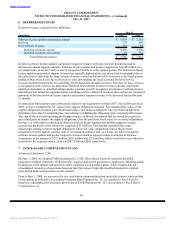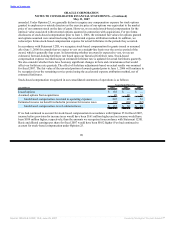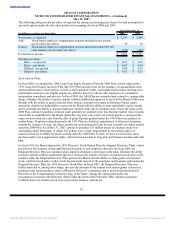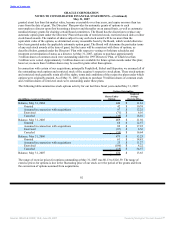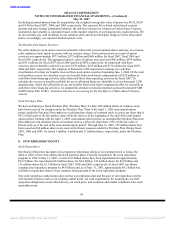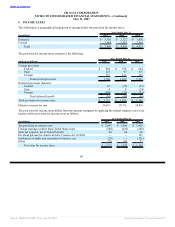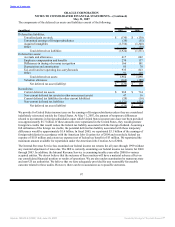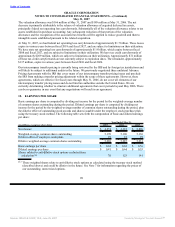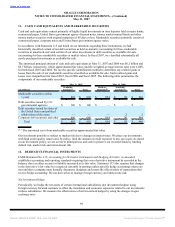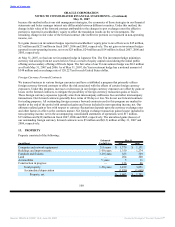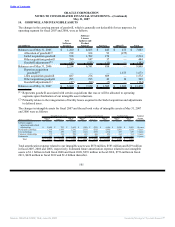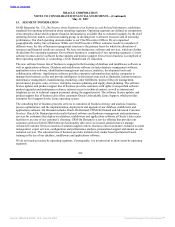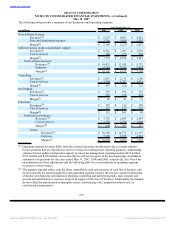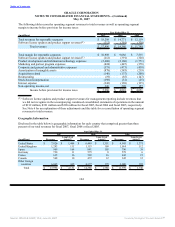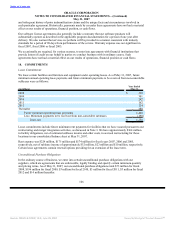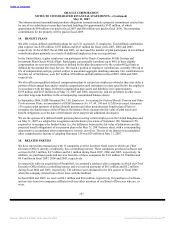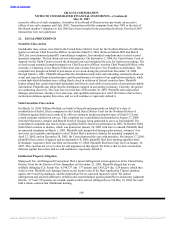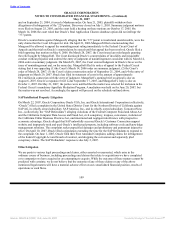Oracle 2006 Annual Report Download - page 106
Download and view the complete annual report
Please find page 106 of the 2006 Oracle annual report below. You can navigate through the pages in the report by either clicking on the pages listed below, or by using the keyword search tool below to find specific information within the annual report.
Table of Contents
ORACLE CORPORATION
NOTES TO CONSOLIDATED FINANCIAL STATEMENTS—(Continued)
May 31, 2007
11. CASH, CASH EQUIVALENTS AND MARKETABLE SECURITIES
Cash and cash equivalents consist primarily of highly liquid investments in time deposits held at major banks,
commercial paper, United States government agency discount notes, money market mutual funds and other
money market securities with original maturities of 90 days or less. Marketable securities primarily consist of
commercial paper, corporate notes and Unites States government agency notes.
In accordance with Statement 115 and based on our intentions regarding these instruments, we had
historically classified certain of our debt securities as held-to-maturity (accounting for these marketable
securities at amortized cost) and certain of our other investments in debt securities as available-for-sale
(accounting for these marketable securities at market value). In fiscal 2007, we classified substantially all
newly purchased investments as available-for-sale.
The amortized principal amount of cash and cash equivalents at May 31, 2007 and 2006 was $6.2 billion and
$6.7 billion, respectively, which approximated fair value, and the weighted-average interest rates were 4.08%
for both fiscal 2007 and 2006. We use the specific identification method to determine any realized gains or
losses from the sale of our marketable securities classified as available-for-sale. Such realized gains and
losses were insignificant for fiscal 2007, fiscal 2006 and fiscal 2005. The following table summarizes the
components of our marketable securities:
May 31, 2007 May 31, 2006
Available- Held-to- Available-
(in millions) for-Sale(1) Total Maturity(1) for-Sale(1) Total
Marketable securities (within
1 year) $ 802 $ 802 $ 854 $ 92 $ 946
Debt securities issued by U.S.
governmental agencies $ 106 $ 106 $ — $ — $ —
Debt securities issued by states of
the United States and political
subdivisions of the states — — — 2 2
Corporate debt securities and other 696 696 854 90 944
Total $ 802 $ 802 $ 854 $ 92 $ 946
(1) The amortized cost of our marketable securities approximated fair value.
Our investment portfolio is subject to market risk due to changes in interest rates. We place our investments
with high credit quality issuers and, by policy, limit the amount of credit exposure to any one issuer. As stated
in our investment policy, we are averse to principal loss and seek to preserve our invested funds by limiting
default risk, market risk and reinvestment risk.
12. DERIVATIVE FINANCIAL INSTRUMENTS
FASB Statement No. 133, Accounting for Derivative Instruments and Hedging Activities, as amended,
establishes accounting and reporting standards requiring that every derivative instrument be recorded in the
balance sheet as either an asset or liability measured at its fair value. Statement 133 also requires that changes
in the derivative’s fair value be recognized currently in earnings unless specific hedge accounting criteria are
met and that a company must formally document, designate and assess the effectiveness of transactions that
receive hedge accounting. We use derivatives to manage foreign currency and interest rate risk.
Net Investment Hedges
Periodically, we hedge the net assets of certain international subsidiaries (net investment hedges) using
foreign currency forward contracts to offset the translation and economic exposures related to our investments
in these subsidiaries. We measure the effectiveness of net investment hedges by using the changes in spot
exchange rates
99
Source: ORACLE CORP, 10-K, June 29, 2007 Powered by Morningstar® Document Research℠


